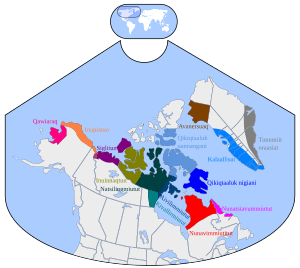Aivilingmiutut facts for kids
Quick facts for kids Aivilik |
|
|---|---|
| Aivilingmiutut | |
| Native to | Canada |
| Region | Aivilik, Nunavut |
| Ethnicity | Aivilingmiut |
| Native speakers | (unknown) |
| Language family | |
| Linguist List | ike-aiv |

Inuit dialects. Aivilik is the dark blue to the west of Hudson Bay.
|
|

|
|
Aivilik, also called Aivilingmiutut, is a special way of speaking the Inuit language. People speak it along the northwestern shores of Hudson Bay in Nunavut, Canada. It is often seen as a dialect of Inuktitut. However, some experts also link it to Inuvialuk. These languages are very similar, forming a "dialect continuum." This means they blend into each other without clear borders.
Contents
What is Aivilik?
Aivilik is a unique dialect spoken by the Aivilingmiut people. It is part of the larger Inuit language family. This family includes many dialects spoken across the Arctic. A dialect is a different form of a language. It has its own sounds, words, and grammar.
Where is Aivilik Spoken?
The Aivilik dialect is spoken in the Aivilik region of Nunavut. This area is in northern Canada. It stretches along the coast of Hudson Bay. The communities here are often small and spread out.
Aivilik and its Neighbors
Aivilik is spoken near other Inuit dialects. This is why it shares features with both Inuktitut and Inuvialuk. Imagine a chain of languages. Each link is slightly different from its neighbor. But the links at the ends of the chain might be very different.
Who Speaks Aivilik?
The Aivilingmiut people are the main speakers of Aivilik. They are an Inuit group. Their history is deeply connected to the land and sea. They have lived in the Arctic for thousands of years.
The Importance of Language
For the Aivilingmiut, their language is very important. It helps them share stories and traditions. It connects them to their ancestors. Language is a big part of their identity and culture.
Is Aivilik in Danger?
Sadly, Aivilik is considered a vulnerable language. This means fewer people are learning it. The UNESCO Atlas of the World's Languages in Danger lists it this way. When a language becomes vulnerable, it needs help to survive.
Protecting Aivilik
Many people are working to protect and promote Aivilik. They want to make sure it continues to be spoken. This includes teaching it in schools. It also means creating new books and media in the language. Keeping a language alive helps keep a culture strong.

